17 Best Waterfalls In Tennessee, According to Local Hikers
Take a long hike through the forest for a secluded cascade or grab a quick photo of a fall you can drive up to see.
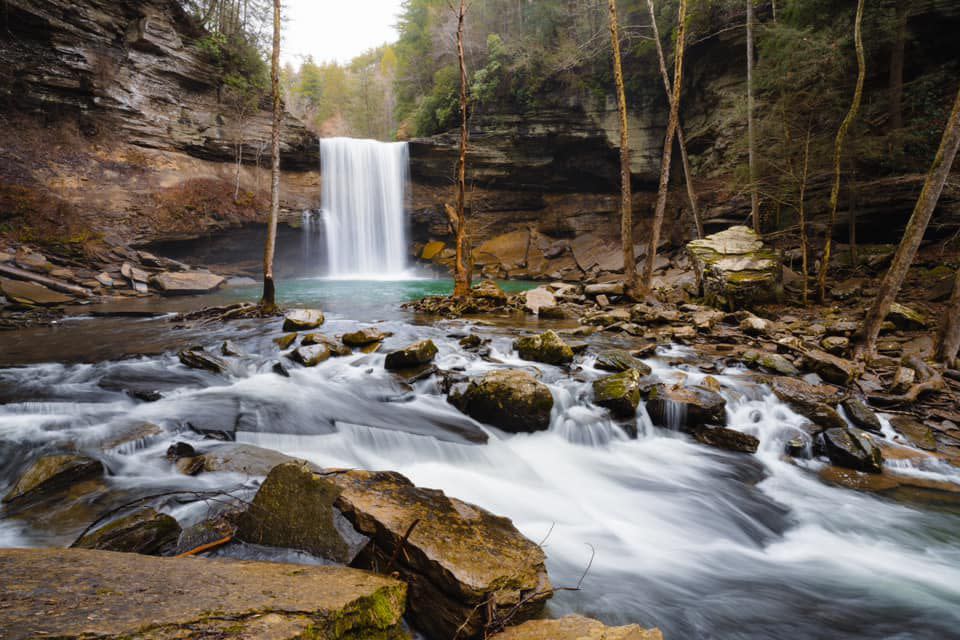
Megan Callahan, Average Wild Experience
Estimates of the number of waterfalls in Tennessee range from around 500 to nearly 900. These cascades vary from tranquil trickles to roaring rapids and find their homes on private property and in state parks, National Park Service sites, U.S. Forest Service land, and city green spaces. Some require multi-mile hikes to reach, while others are accessible from roadsides.
Where Are Tennessee's Best Waterfalls Located?
You’ll find the bulk of the state’s waterfalls in Middle and East Tennessee, where the Highland Rim, Cumberland Plateau, and Appalachian and Blue Ridge Mountains meet extensive river and stream systems. While waterfall viewing can be a treat year-round, spring is an ideal season to check them out when the region’s increased rainfall and snowmelt add to their flow.
What Should You Know Before You Go?
Whenever you visit Tennessee’s waterfalls, it’s important to remember Leave No Trace ethics—a set of principles created to help us all enjoy outdoor spaces while reducing long-term impacts on these precious resources. Consider visiting waterfalls with fewer crowds to limit the strain placed on agencies tasked with protecting them. Make sure to pack out any trash or other items you brought, and leave everything else as you found it, including rocks, flowers, and branches. This ensures that generations to come can enjoy these picturesque waterfalls too.
What Are The Best Waterfalls In Tennessee?
Now, to round up a list of the “best” waterfalls in Tennessee is a bit of a futile challenge—but that doesn’t mean we didn’t try. Your best bet is to commit to a lifetime of chasing waterfalls in the Volunteer State. But, in case you’re limited on time, we’ve rounded up 17 of Tennessee’s best waterfalls using personal experience and crowdsourcing information from local adventure groups like Girls Who Hike Tennessee and regional experts who live and play throughout the state. We hope it gets your waterfall adventures started.
Machine Falls
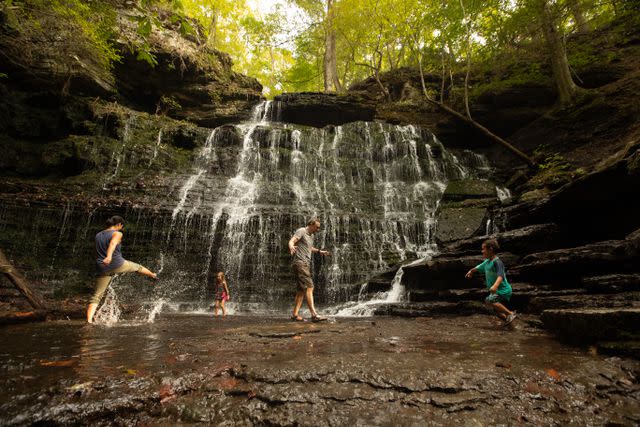
Tennessee Tourism
The 420-acre Short Springs Natural Area in Tullahoma boasts the popular Machine Falls, which drops about 60 feet and is nearly equal in its length across. Reaching the waterfall requires a 1.5-mile loop trail. Hikers will be able to view exposed black Chattanooga shale—a geologic formation that delineates the Central Basin in Tennessee from the Highland Rim—at the mid-slope when descending the trail to the waterfall. Spring also brings mountain laurel blooms along the upper slopes.
Northrup Falls
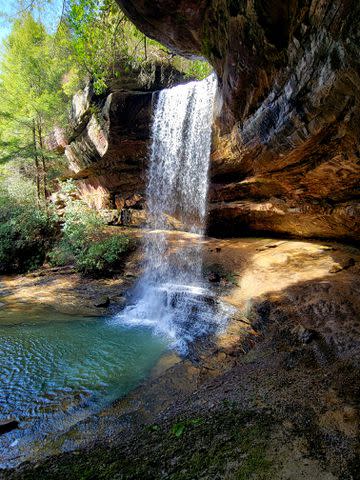
Amy Satterwhite
Northrup Falls is the defining feature of Colditz Cove, a 165-acre natural area in Fentress County. It plunges more than 60 feet over a rock shelf into a narrow gorge on Big Branch Creek. Hikers can access it via a roughly 1.5-mile loop trail. It’s named after the family who settled in the area and operated a mill above the falls in the 1800s.
Conasauga Falls
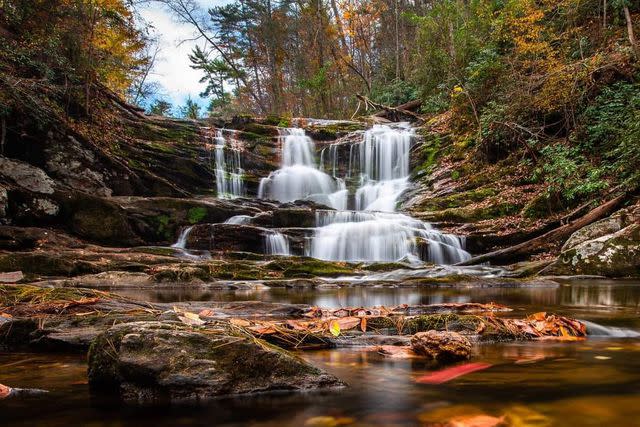
Victoria Stamey, VS Outdoor Snaps
A 1.5-mile out-and-back hike on Conasauga Falls Trail #170 in Cherokee National Forest will bring you to a beautiful three-tiered waterfall—a relatively short hike for a breathtaking reward. Expect about 400 feet in elevation gain during your trek. There is a circular parking area for the trail at the end of a dirt road.
Spruce Flat Falls
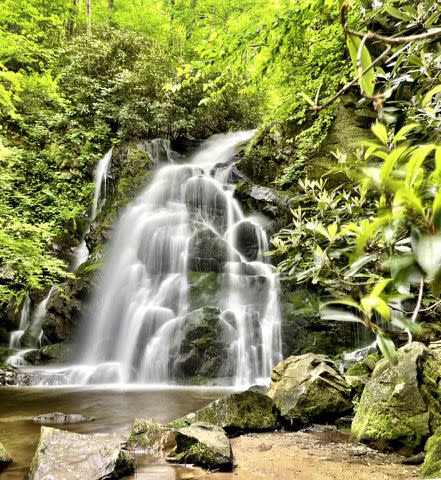
Ashlee Taylor
Located in Great Smoky Mountains National Park, the out-and-back hike to Spruce Flat Falls is 1.8 miles. The trail is short, but has some steep sections with lots of rocks and roots to navigate. While still a popular waterfall hike in the Smokies, Spruce Flat Falls is often quieter than some of the other well-known trailheads in the park, such as Laurel Falls. The trail doesn’t appear on the official park trail map, but hikers will find signage for it near the Great Smoky Mountains Institute at Tremont near the parking area.
Greeter Falls
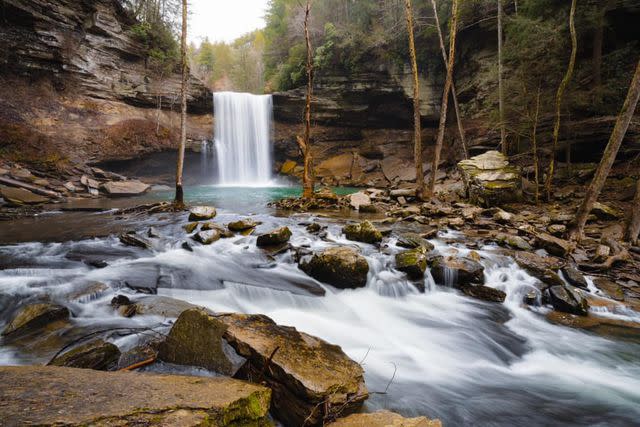
Megan Callahan, Average Wild Experience
You’ll find Greeter Falls about 45 minutes northwest of Chattanooga in the Savage Gulf State Natural Area of South Cumberland State Park. About one mile round trip, this out-and-back hike will take you through hardwood forests and aside sandstone cliffs. You’ll get to view both the upper and lower falls.
Lost Creek Falls
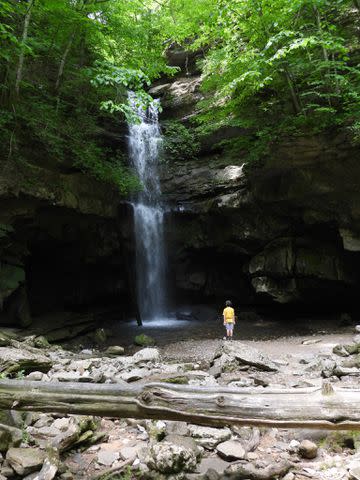
Holly Taylor
The walk to Lost Creek Falls is short and easy, about 0.2 miles. The waterfall is located in Lost Creek State Natural Area in Sparta, about an hour and half east of Nashville. The natural area includes one of Tennessee’s largest caves. After you view Lost Creek Falls, you can continue to the cave across from it, which also houses a waterfall inside. Note that the cave is closed for recreational use during the hibernation and swarming times of the federally protected Indiana bat population that lives there. During other parts of the year, you must obtain a no-cost permit from the Nature Center at Fall Creek Falls State Park to enter.
Burgess Falls
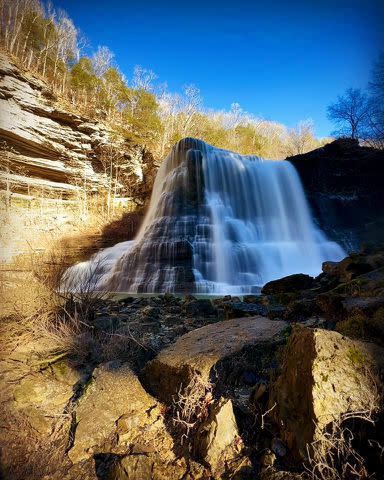
Tara Hunt
Burgess Falls is located in a 217-acre natural area southwest of Cookeville. The park has stunning bluffs, diverse forests, and three waterfalls formed by Falling Water River. Burgess Falls is the area’s most impressive, plunging more than 130 feet into the gorge at a sharp edge of the riverbed. You can hike the 1.5-mile River Trail loop to view the waterfall. For an even more memorable experience, consider using a guide service like Kayaking Adventures of Tennessee to paddle up to the base of Burgess Falls.
Slave Falls
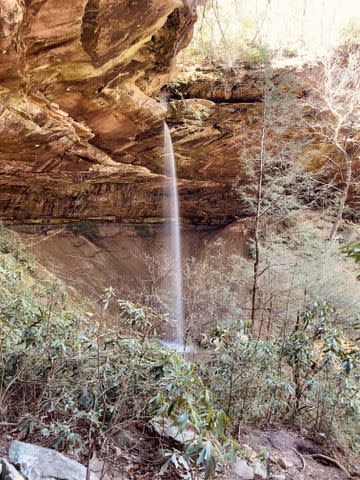
Arnita Sitasari Gray
Slave Falls is located in Big South Fork National River & Recreation Area. The hike to it is about three miles round-trip and relatively easy. In addition to the 60-foot waterfall, you’ll get to see a natural arch formation called Needle Arch. Note that in late summer and fall there may be very little water coming over the falls, so plan to view it earlier in the season for maximum flow. However, the hike is beautiful year-round.
Twin Falls
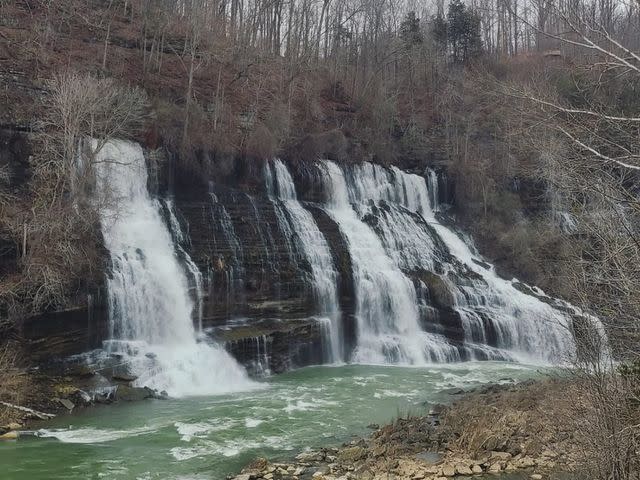
Frankie Anne Runge
Twin Falls is located in Rock Island State Park, an 833-acre nature area on the headwaters of Center Hill Lake at the confluence of the Caney Fork, Collins, and Rocky Rivers. The waterfalls pour out of the walls of the gorge rather than over the top, and formed when the Caney Fork River was dammed. Twin Falls is relatively accessible, requiring a short walk down some steep stairs from the parking area. Note that the area is subject to sudden rises in water if the floodgates at Great Falls Dam are opened. Listen for warning sirens from the dam and do not swim or wade in the area.
Big Branch Falls
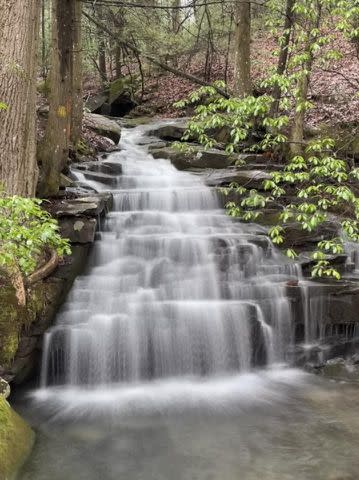
Ashley Norman
Big Branch Falls is located in Tennessee’s Virgin Falls State Natural Area, a 1,157-acre preserve in the Cumberland Plateau region. It’s the first of four waterfalls you can see in the park on a nine-mile round-trip hike. Others include Big Laurel Falls, Sheep Cave Falls, and Virgin Falls—the latter of which is formed from an underground stream that exits from a cave and drops 110 feet over a cliff before vanishing into another cave! Visit Big Branch Falls to get a taste of this waterfall wonderland, or opt for a longer day exploring all four.
Denny Cove Falls
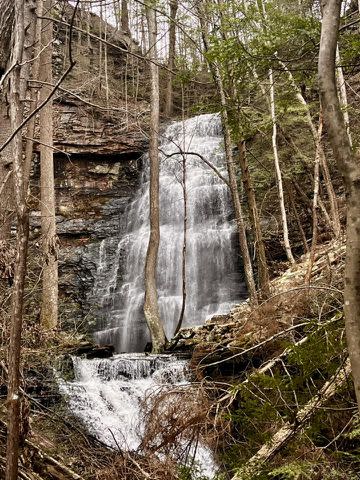
Lynde Davis
Denny Cove is a 685-acre natural area added to South Cumberland State Park in 2016 thanks to a joint effort by the park, the Land Trust for Tennessee, Southeastern Climbers Coalition, The Access Fund, and The Conservation Fund. The region is particularly popular with rock climbers. Visitors can hike the park’s one-mile Waterfall Trail to view Denny Cove Falls, which cascades down 70 feet. Note that the trail involves some technical sections, so may take hikers longer than their average mile.
Black Canyon Falls
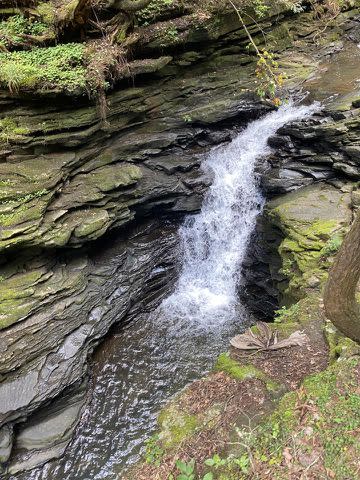
Rachel Runner
You can find Black Canyon Falls in the Grundy Forest Natural Area of South Cumberland State Park near Tracy City. The waterfall has a 15-foot drop and can be reached with a 1.8-mile round-trip hike on Fiery Gizzard Trail. While lighting can sometimes make it challenging to photograph, seeing the waterfall’s flow in person is a must.
Hemlock Falls
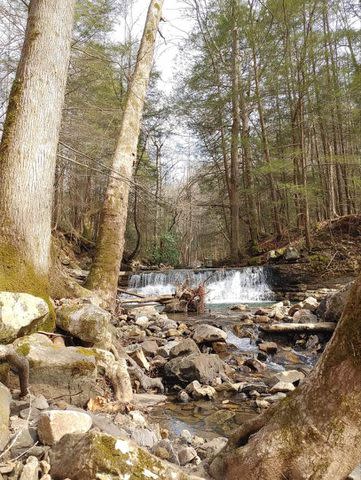
Caroline Oakes
Many flock to Fall Creek Falls State Park for its namesake, Fall Creek Falls, a 256-foot waterfall that is one of the highest in the eastern United States. The park boasts several other popular waterfalls as well, such as Cane Creek Falls and Cane Creek Cascades. While all are worth a gaze, consider taking some time to explore the park’s lesser-frequented gems, such as Hemlock Falls. To reach this sweet little cascade, hike Prater Place Trail on the northern side of the park. The out-and-back trek is about 6.2 miles with around 650 feet in elevation gain.
Cummins Falls
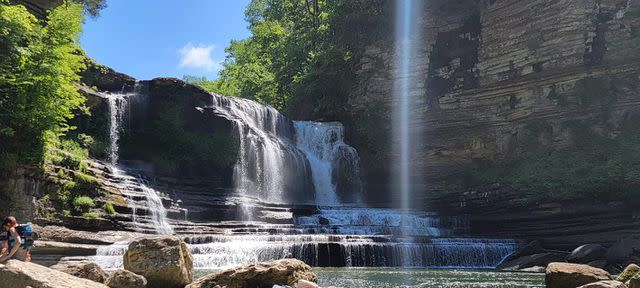
Joeleane Smith
Cummins Falls is the eighth largest waterfall by water volume in Tennessee and stands at 75 feet high. It’s located about nine miles north of Cookeville on the Blackburn Fork State Scenic River in the 306-acre Cummins Falls State Park. Visitors should note that a Gorge Access Permit is required to travel to the waterfall’s base. Since the gorge is prone to flash flooding, access to the waterfall’s base is only available on fair-weather days. Be prepared for a 1.5-mile strenuous hike into the gorge that may require rock scrambling and wading or swimming in the water.
Laurel Run Falls
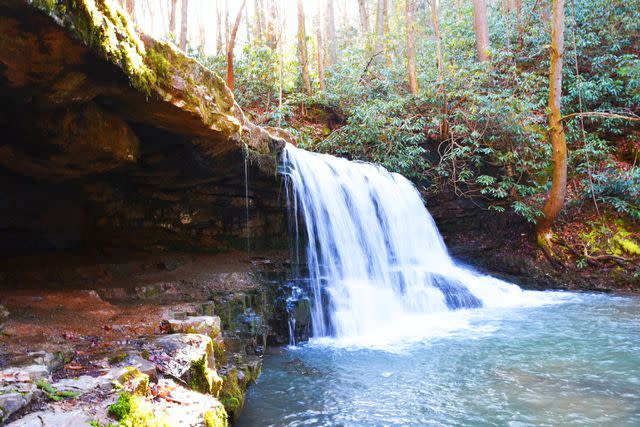
Allie Bynum, Northeast TN Tourism
Laurel Run Park—home to this scenic waterfall—sits on the Holston River and was the backdrop for the 1984 film, The River, starring Mel Gibson and Sissy Spacek. It’s located in Churchill, just west of Kingsport. Expect about a 1.8-mile round-trip to Laurel Run Falls, with abundant wildflowers along the way if you hike it in spring.
Ozone Falls
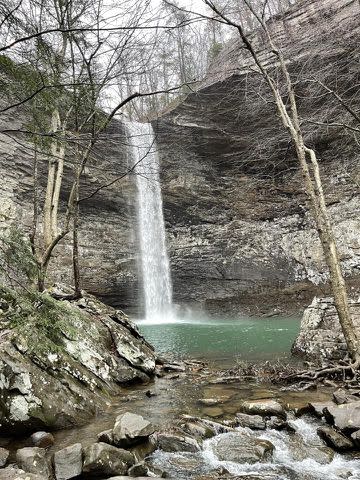
Becca Wolfe
Plunging 110 feet over a sandstone cap rock, Ozone Falls was featured in scenes of the movie, Jungle Book. The waterfall is located in a 43-acre natural area close to Interstate 40, about 15 miles east of Crossville. You can access it via a 0.3-mile out-and-back hike.
Piney Falls
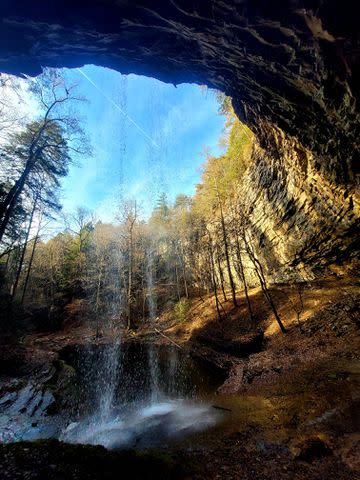
Destiny Cornett
Piney Falls Natural Area encompasses 818 acres and is recognized as a National Natural Landmark—a designation given to the country’s best lasting instances of major biotic communities and geologic features. Piney Falls drops around 80 feet from its upper portion into a pool and then another 40 feet from its lower portion. The hike to the waterfall is about a 1.8-mile loop. You’ll also see old-growth forest in the area, with trees more than 40 inches in diameter and 100 feet in height.
For more Southern Living news, make sure to sign up for our newsletter!
Read the original article on Southern Living.

